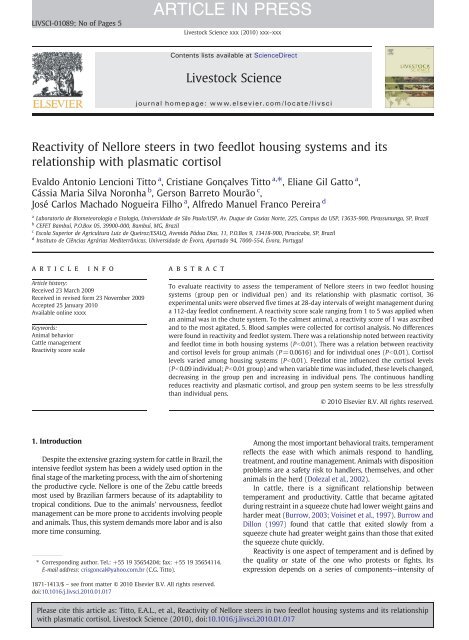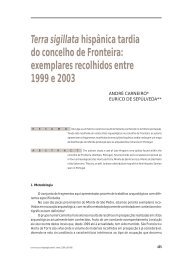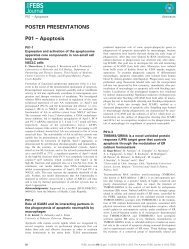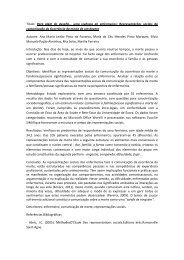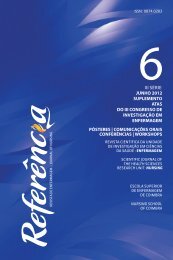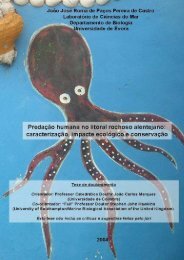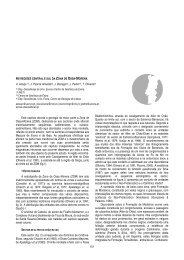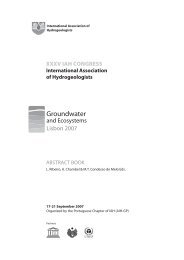Reactivity of Nellore steers in two feedlot housing systems and its ...
Reactivity of Nellore steers in two feedlot housing systems and its ...
Reactivity of Nellore steers in two feedlot housing systems and its ...
You also want an ePaper? Increase the reach of your titles
YUMPU automatically turns print PDFs into web optimized ePapers that Google loves.
ARTICLE IN PRESSE.A.L. Titto et al. / Livestock Science xxx (2010) xxx–xxx3<strong>Reactivity</strong> 1: the effect <strong>of</strong> the treatment (<strong>in</strong>dividual pen orgroup), cortisol as covariable <strong>in</strong> the treatment, effect on theanimal <strong>and</strong> residual as r<strong>and</strong>om.<strong>Reactivity</strong> 2: treatment effect, time as covariable (l<strong>in</strong>ear<strong>and</strong> quadratic), effect on the animal <strong>and</strong> residual as r<strong>and</strong>om.The results are presented as least square means throughthe F test. The effects <strong>of</strong> the possible <strong>in</strong>teractions that werenot significant (PN0.10) <strong>in</strong> the study <strong>and</strong>/or could not betested due to the distribution <strong>of</strong> the <strong>in</strong>formation werewithdrawn from the study's f<strong>in</strong>al analysis. Statistical comparisonswere made on least square means with an approximationus<strong>in</strong>g chi-square test.3. ResultsAlthough there was no significant difference <strong>in</strong> thereactivity parameter consider<strong>in</strong>g the k<strong>in</strong>d <strong>of</strong> hous<strong>in</strong>g, grouppen or <strong>in</strong>dividual pen, the reactivity tends to reduce (Pb0.01)consider<strong>in</strong>g the long stay <strong>of</strong> the <strong>steers</strong> <strong>in</strong> the <strong>feedlot</strong> until theirtransfer to the slaughterhouse (Fig. 1; Table 2).There was a relation between reactivity <strong>and</strong> cortisol levelsfor animals <strong>in</strong> group pen (P=0.0616) <strong>and</strong> <strong>in</strong> <strong>in</strong>dividual pens(P b0.01). However, this relationship was positive forgrouped animals <strong>and</strong> negative for <strong>in</strong>dividual ones (Table 3).There was a positive effect <strong>of</strong> time spent <strong>in</strong> the <strong>feedlot</strong> <strong>in</strong>relation to cortisol sampled from the animals <strong>in</strong> the <strong>in</strong>dividualpens (P=0.09) <strong>and</strong> a negative relation was found for animals<strong>in</strong> the group pens (Pb0.01; Table 3; Fig. 2). The cortisol levelssampled from the grouped animals tend to decrease along thetime. There was <strong>in</strong>teraction between day <strong>of</strong> sampl<strong>in</strong>g <strong>and</strong>cortisol values <strong>of</strong> the animals.The cortisol levels differed between hous<strong>in</strong>g <strong>systems</strong>,<strong>in</strong>dividual or group (Pb0.01; Table 3). The higher meanvalues were found for the group (28.36 ng/mg) as aga<strong>in</strong>st the<strong>in</strong>dividual pens' 18.79 ng/mg (Fig. 3).4. DiscussionThe subsequent experiences with weigh<strong>in</strong>g resulted <strong>in</strong> adecrease <strong>of</strong> reactivity scores <strong>in</strong>dependent <strong>of</strong> sett<strong>in</strong>g (<strong>in</strong>dividualor group). These results are similar to the f<strong>in</strong>d<strong>in</strong>gs <strong>of</strong>Crookshank et al. (1979) <strong>and</strong> Curley et al. (2006)—the moreacqua<strong>in</strong>ted to the procedure the animal is, the less reactionthey present. On the other h<strong>and</strong>, us<strong>in</strong>g flight speed (FS) asTable 2Least square means <strong>of</strong> reactivity scores for <strong>steers</strong> housed <strong>in</strong> group pen or<strong>in</strong>dividual pen, <strong>and</strong> relation with <strong>feedlot</strong> time (112 days).β SEM P-valueCortisol (<strong>in</strong>dividual pen) 0.08369 0.02565 b0.0026Cortisol (group pen) 0.01412 0.007297 b0.0616Feedlot time (112 days) +0.02152 0.006068 b0.0012another tool to measure temperament, some authors foundthat FS <strong>in</strong>creased slightly over time <strong>in</strong> both B. <strong>in</strong>dicus <strong>and</strong> B.taurus cattle (Müller <strong>and</strong> von Keyserl<strong>in</strong>gk, 2006; Pethericket al., 2002). Authors may attribute this <strong>in</strong>crease to repeatedh<strong>and</strong>l<strong>in</strong>g <strong>of</strong> the test animals, which may led to an <strong>in</strong>crease <strong>in</strong>their fearfulness (Petherick et al., 2002). Because an animal'sbehavior can be <strong>in</strong>fluenced by past experiences, scor<strong>in</strong>gshould be conducted at wean<strong>in</strong>g. This will reduce the extentto which current behavior has been <strong>in</strong>fluenced by priorh<strong>and</strong>l<strong>in</strong>g experiences (Dolezal et al., 2002). Nevertheless, <strong>in</strong>the present study, there was no stressful h<strong>and</strong>l<strong>in</strong>g; onlypositive experiences were looked for, avoid<strong>in</strong>g fear memoriesthat can never be erased.Temperament <strong>and</strong> stress have been closely associated, <strong>and</strong>the behavior <strong>of</strong> cattle has become a method for <strong>in</strong>dicat<strong>in</strong>g orselect<strong>in</strong>g cattle that could be more stress responsive cattle orless adaptive (Curley et al., 2006).The animals that lived alone (<strong>in</strong> <strong>in</strong>dividual pens) did notlearn to express a normal submissive behavior, on the otherh<strong>and</strong>, animals <strong>in</strong> group pens learned how <strong>and</strong> when to limittheir aggressiveness through <strong>in</strong>teraction with peers (Price <strong>and</strong>Wallach, 1990). This explanation matches the f<strong>in</strong>d<strong>in</strong>gs <strong>of</strong> thisresearch—the <strong>steers</strong> that were kept alone presented visibleaggressive tra<strong>its</strong> dur<strong>in</strong>g h<strong>and</strong>l<strong>in</strong>g, especially toward the end <strong>of</strong>the experiment. Many tests to assess fear <strong>in</strong>corporate socialisolation (Mason, 2000).The results found for <strong>steers</strong> placed <strong>in</strong> pens confirmed theobservations <strong>of</strong> Andrighetto et al. (1999), who studied social<strong>in</strong>teractions among young cattle; they detected certa<strong>in</strong> socialbehaviors with<strong>in</strong> a group, like visual, vocal <strong>and</strong> olfactorycommunications. It helped to m<strong>in</strong>imize the habitual discomfort<strong>of</strong> a <strong>feedlot</strong> environment, which is limited <strong>in</strong> space <strong>and</strong>comfort, thus mak<strong>in</strong>g the animals less reactive <strong>and</strong> lessphysiological stressed.Becker <strong>and</strong> Lobato (1997) reported that the smallestreactivity scores presented at the end <strong>of</strong> certa<strong>in</strong> processessuch as rais<strong>in</strong>g <strong>and</strong> h<strong>and</strong>l<strong>in</strong>g, happened because <strong>of</strong> adaptationto human h<strong>and</strong>l<strong>in</strong>g <strong>and</strong> to facilities used, which is alsoresponsible for the lower cortisol levels <strong>of</strong> these animals.Relationship found between high levels <strong>of</strong> cortisol <strong>and</strong> greaterhesitation when enter<strong>in</strong>g a stressful situation (a hold<strong>in</strong>gTable 3Least square means <strong>of</strong> plasmatic cortisol for <strong>steers</strong> housed <strong>in</strong> group pen or<strong>in</strong>dividual pen, <strong>and</strong> relation with <strong>feedlot</strong> time (112 days).Hous<strong>in</strong>gsystemPlasmaticcortisolβFeedlot timeFig. 1. Variation <strong>in</strong> reactivity <strong>in</strong> <strong>steers</strong> housed <strong>in</strong> group or 1 <strong>in</strong>dividual pensthroughout the <strong>feedlot</strong> time. Dur<strong>in</strong>g the <strong>feedlot</strong> period, reactivity was observedevery time the animals were weighed (n=36). The po<strong>in</strong>ts show the observedreactivity for the <strong>two</strong> hous<strong>in</strong>g <strong>systems</strong> <strong>and</strong> the l<strong>in</strong>e shows the mean predictedvalues for both <strong>systems</strong>.Mean SEM SEM P-valueIndividual pen 13.6 b 3.32 +0.07708 0.0448 b0.09Group pen 22.9 a 2.35 −0.1494 0.0368 b0.0001Different superscript letters differ (Pb0.01).Please cite this article as: Titto, E.A.L., et al., <strong>Reactivity</strong> <strong>of</strong> <strong>Nellore</strong> <strong>steers</strong> <strong>in</strong> <strong>two</strong> <strong>feedlot</strong> hous<strong>in</strong>g <strong>systems</strong> <strong>and</strong> <strong>its</strong> relationshipwith plasmatic cortisol, Livestock Science (2010), doi:10.1016/j.livsci.2010.01.017
ARTICLE IN PRESS4 E.A.L. Titto et al. / Livestock Science xxx (2010) xxx–xxxthe differences <strong>of</strong> cortisol levels could be the physiologicalanswer <strong>in</strong> stress situation. The h<strong>and</strong>l<strong>in</strong>g system was the same <strong>in</strong>the <strong>two</strong> hous<strong>in</strong>g <strong>systems</strong>, so liv<strong>in</strong>g as a group can be attributedto the decreased <strong>of</strong> plasmatic cortisol concentrations as cattleare gregarious animals (Bouissou et al., 2001).5. ConclusionFig. 2. Mean concentrations <strong>of</strong> plasma cortisol <strong>of</strong> <strong>steers</strong> housed <strong>in</strong> the<strong>in</strong>dividual pens or group pen dur<strong>in</strong>g <strong>feedlot</strong> period. Animals blood wasdrawn every 28 days after the reactivity score was assigned (n=12 for<strong>in</strong>dividual; n= 24 for group).corral) <strong>and</strong> more vocalizations <strong>in</strong> the stressful situationprovide strong <strong>and</strong> consistent evidence that cortisol levelsare related to anxiety-related behaviors <strong>in</strong> cattle <strong>in</strong> nonstressful<strong>and</strong> stressful situations (Bristow <strong>and</strong> Holmes, 2007).Gr<strong>and</strong><strong>in</strong> (1993) also found that repeated weigh<strong>in</strong>g resulted<strong>in</strong> a lower mean value <strong>of</strong> cortisol concentration. The decrease<strong>of</strong> cortisol could suggest physiological down-regulation oradaptation to the new environment (Higashiyama et al.,2007).Cattle tend to be less agitated dur<strong>in</strong>g h<strong>and</strong>l<strong>in</strong>g if they aregrouped rather than s<strong>in</strong>gle (Gr<strong>and</strong><strong>in</strong>, 1987), probably becausethey are less fearful (Petherick et al., 2002). Therefore, asreactivity seems to reduce along the <strong>feedlot</strong> period, thisallowed us to suppose that hous<strong>in</strong>g animals as a group is abetter <strong>feedlot</strong> system as plasmatic cortisol levels decreasedalong conf<strong>in</strong>ement period.There is a possibility that the higher mean value <strong>of</strong> detectedcortisol <strong>in</strong> the animals <strong>in</strong> group pens was due to a higher stresslevel dur<strong>in</strong>g adaptation to learn how to use the electronic gatesat the feed<strong>in</strong>g bunks. These hormonal changes presumablycould underlie adaptive changes.The chronic stress could be another explanation <strong>of</strong> thereduc<strong>in</strong>g <strong>of</strong> cortisol levels <strong>in</strong> grouped animals. A decrease <strong>in</strong>plasma cortisol levels has been observed previously <strong>in</strong>chronically heat-stressed cows (Bell et al., 1989; Christison<strong>and</strong> Johnson, 1972). Although reactivity behavior seems to havethe same decrease tendency between the <strong>two</strong> hous<strong>in</strong>g types,Fig. 3. Evolution <strong>of</strong> cortisol levels (dotted l<strong>in</strong>e) <strong>and</strong> reactivity scores (full l<strong>in</strong>e)observed <strong>in</strong> group pen animals (n=24) weighed every 28 days. Blood sampleswere drawn after the reactivity score was assigned.The results <strong>of</strong> this study show that hous<strong>in</strong>g cattle <strong>in</strong> groupor <strong>in</strong>dividual <strong>in</strong> <strong>feedlot</strong>s did not alter reactivity <strong>of</strong> weigh<strong>in</strong>g,which reduced along the conf<strong>in</strong>ement period. However, thecortisol levels tend to <strong>in</strong>crease <strong>in</strong> <strong>in</strong>dividual housed animals<strong>and</strong> decreased <strong>in</strong> grouped animals. This relationship betweencortisol <strong>and</strong> hous<strong>in</strong>g system should be considered withcaution <strong>and</strong> warrants further <strong>in</strong>vestigation to avoid thehypothesis <strong>of</strong> chronic stress <strong>in</strong> animals <strong>in</strong> group.ReferencesAndrighetto, I., Gottardo, F., Andreolli, D., Cozzi, G., 1999. Effect <strong>of</strong> type <strong>of</strong>hous<strong>in</strong>g on veal calf growth performance, behaviour <strong>and</strong> meat quality.Livestock Prod. Sci. 57, 137–145.Becker, A., Lobato, J.F.P., 1997. Effects <strong>of</strong> gentle h<strong>and</strong>l<strong>in</strong>g on the reactivity <strong>of</strong>zebu crossed calves to human. Appl. Anim. Behav. Sci. 53, 219–224.Bell, A.W., McBride, B.W., Slepetis, R., Early, R.J., Currie, W.B., 1989. Chronicheat stress <strong>and</strong> prenatal development <strong>in</strong> sheep: I. Conceptus growth <strong>and</strong>maternal plasma hormones <strong>and</strong> metabolites. J. Anim. Sci. 67, 3289–3299.Bouissou, M.F., Boissy, A., Ne<strong>in</strong>dre, P.L., Veissier, I., 2001. The social behaviour<strong>of</strong> cattle. In: Keel<strong>in</strong>g, L.J., Gonyou, H.W. (Eds.), Social Behavior <strong>in</strong> FarmAnimals. CABI Publish<strong>in</strong>g, Wall<strong>in</strong>gford, pp. 113–135.Bristow, D.J., Holmes, D.S., 2007. Cortisol levels <strong>and</strong> anxiety-related behaviors<strong>in</strong> cattle. Physiol. Behav. 90, 626–628.Burrow, H.M., 1997. Measurements <strong>of</strong> temperament <strong>and</strong> their relationshipswith performance tra<strong>its</strong> <strong>of</strong> beef cattle. Anim. Breed<strong>in</strong>g Abstr. 65,477–495.Burrow, H.M. 2003. Improv<strong>in</strong>g cattle performance <strong>and</strong> meat quality bymeasur<strong>in</strong>g temperament. On homepage <strong>of</strong> Cooperative Research Centrefor cattle <strong>and</strong> Beef Quality. (2003), http://www.beef.crc.org.au.Burrow, H.M., Dillon, R.D., 1997. Relationship between temperament <strong>and</strong>growth <strong>in</strong> a <strong>feedlot</strong> <strong>and</strong> commercial carcass tra<strong>its</strong> <strong>of</strong> Bos <strong>in</strong>dicuscrossbreeds. Aust. J. Exp. Agric. 37, 407–411.Chackleu, S., 1996. The neuroendocr<strong>in</strong>ology <strong>of</strong> depression <strong>and</strong> chronic stress.Brit. Med. Bul. 52 (3), 597–617.Christison, G.I., Johnson, H.D., 1972. Cortisol turnover <strong>in</strong> heat-stressed cows.J. Anim. Sci. 35, 1005–1010.Crookshank, H., Elissaude, N., White, R., Canton, D., Smolley, H., 1979. Effect <strong>of</strong>h<strong>and</strong>l<strong>in</strong>g <strong>and</strong> transportation <strong>of</strong> calves upon blood serum composition. J.Anim. Sci. 48, 430.Curley Jr., K.O., Paschal, J.C., Welsh Jr., T.H., R<strong>and</strong>el, R.D., 2006. Technical note:exit velocity as a measure <strong>of</strong> cattle temperament is repeatable <strong>and</strong>associated with serum concentration <strong>of</strong> cortisol <strong>in</strong> Brahman bulls. J.Anim. Sci. 84, 3100–3103.Dolezal, S. L., D. H. Crews, Jr., M. E. Dikeman, T. W. Marston, L. W. Olson, J. C.Paschal, G. H. Rouse, R. L. Weaber, R. E. Williams <strong>and</strong> D. E. Wilson. 2002.Animal evaluation. In: Guidel<strong>in</strong>es for Uniform Beef ImprovementPrograms, 8th edition. Beef Improvement Federation. Available: www.beefimprovement.org.Fordyce, G., Whites, R.N., Dodt, J.R., 1988. Cattle temperament <strong>in</strong> extensivebeef herds <strong>in</strong> northern Queensl<strong>and</strong>. 1. Factor affect<strong>in</strong>g temperament.Aust. J. Exp. Agric. 28, 683–687.Gr<strong>and</strong><strong>in</strong>, T., 1987. Animal h<strong>and</strong>l<strong>in</strong>g. Vet. Cl<strong>in</strong>. North Am.: Food Anim. Pract. 3,323–338.Gr<strong>and</strong><strong>in</strong>, T., 1993. Behavioral agitation dur<strong>in</strong>g h<strong>and</strong>l<strong>in</strong>g <strong>of</strong> cattle is persistentover time. Appl. Anim. Behav. Sci. 36, 1–9.Hearnshaw, H., Morris, C.A., 1984. Genetic <strong>and</strong> environmental effects on atemperament score <strong>in</strong> beef cattle. Aus. J. Agric. Res. 35, 723–733.Higashiyama, Y., Nashiki, M., Narita, H., Kawasaki, M., 2007. A brief report oneffects <strong>of</strong> transfer from outdoor graz<strong>in</strong>g to <strong>in</strong>door tether<strong>in</strong>g <strong>and</strong> back onur<strong>in</strong>ary cortisol <strong>and</strong> behaviour <strong>in</strong> dairy cattle. Appl. Anim. Behav. Sci. 102,119–123.Mason, W.A., 2000. Early developmental <strong>in</strong>fluences <strong>of</strong> experience onbehavior, temperament <strong>and</strong> stress. In: Moberg, G.P., Mench, J.A. (Eds.),The Biology <strong>of</strong> Animal Stress. CABI Publish<strong>in</strong>g, Wall<strong>in</strong>gford, pp. 269–290.Please cite this article as: Titto, E.A.L., et al., <strong>Reactivity</strong> <strong>of</strong> <strong>Nellore</strong> <strong>steers</strong> <strong>in</strong> <strong>two</strong> <strong>feedlot</strong> hous<strong>in</strong>g <strong>systems</strong> <strong>and</strong> <strong>its</strong> relationshipwith plasmatic cortisol, Livestock Science (2010), doi:10.1016/j.livsci.2010.01.017
ARTICLE IN PRESSE.A.L. Titto et al. / Livestock Science xxx (2010) xxx–xxx5Moberg, G.P., 2000. Biological response to stress: implications for animalwelfare. In: Moberg, G.P., Mench, J.A. (Eds.), The Biology <strong>of</strong> Animal Stress.CABI Publish<strong>in</strong>g, Wall<strong>in</strong>gford, pp. 1–21.Mourão, G.B., Bergmann, J.A.G., Ferreira, M.B.D., 1998. Genetic differences<strong>and</strong> heritability estimates <strong>of</strong> temperament <strong>in</strong> Zebus <strong>and</strong> F1 Holste<strong>in</strong>×-Zebu females. R. Bras. Zootec. 27 (4), 722–729.Müller, R., von Keyserl<strong>in</strong>gk, M.A.G., 2006. Consistency <strong>of</strong> flight speed <strong>and</strong> <strong>its</strong>correlation to productivity <strong>and</strong> to personality <strong>in</strong> Bos taurus beef cattle.Appl. Anim. Behav. Sci. 99, 193–204.Nemer<strong>of</strong>f, C.B., 1996. The corticotrop<strong>in</strong>-realis<strong>in</strong>g factor (CRF) hypothesis <strong>of</strong>depression: new f<strong>in</strong>d<strong>in</strong>gs <strong>and</strong> new directions. Mol. Psychiatry 1 (4), 336.Petherick, J.C., Holroyd, R.G., Doogan, V.J., Venus, B.K., 2002. Productivity,carcass <strong>and</strong> meat quality <strong>of</strong> lot-fed Bos <strong>in</strong>dicus cross <strong>steers</strong> groupedaccord<strong>in</strong>g to temperament. Aust. J. Exp. Agric. 42, 389–398.Price, E.O., Wallach, S.J.R., 1990. Physical isolation on h<strong>and</strong>-reared Herefordbulls <strong>in</strong>creases their aggressiveness towards humans. Appl. Anim. Behav.Sci. 27, 263–267.SAS Institute, Inc., 2004. AS/STAT User's Guide, 12th ed. SAS Inst., Inc, Cary,NC.Tapki, I., Sah<strong>in</strong>, A., 2006. Comparison <strong>of</strong> the thermoregulatory behaviours <strong>of</strong>low <strong>and</strong> high produc<strong>in</strong>g dairy cows <strong>in</strong> a hot environment. Appl. Anim.Behav. Sci. 99, 1–11.Vois<strong>in</strong>et, B.T., Gr<strong>and</strong><strong>in</strong>, T., Patum, S.F., O'Connor, S.F., Struthers, J.J., 1997.Feedlot cattle with calm temperament have higher average daily ga<strong>in</strong>than cattle with excitable temperament. J. Anim. Sci. 75, 892–896.Please cite this article as: Titto, E.A.L., et al., <strong>Reactivity</strong> <strong>of</strong> <strong>Nellore</strong> <strong>steers</strong> <strong>in</strong> <strong>two</strong> <strong>feedlot</strong> hous<strong>in</strong>g <strong>systems</strong> <strong>and</strong> <strong>its</strong> relationshipwith plasmatic cortisol, Livestock Science (2010), doi:10.1016/j.livsci.2010.01.017


